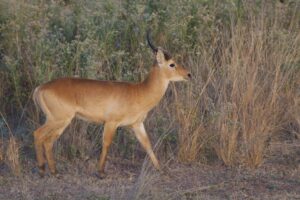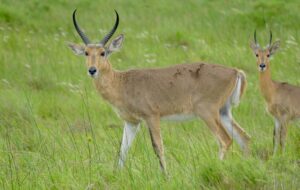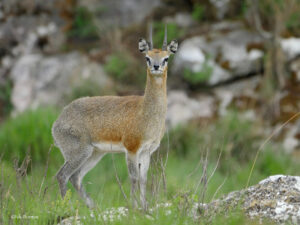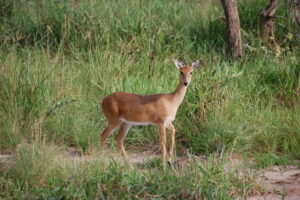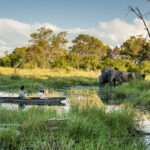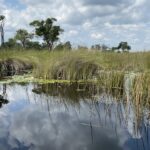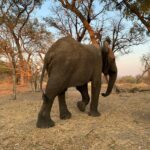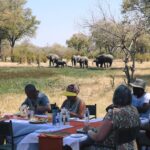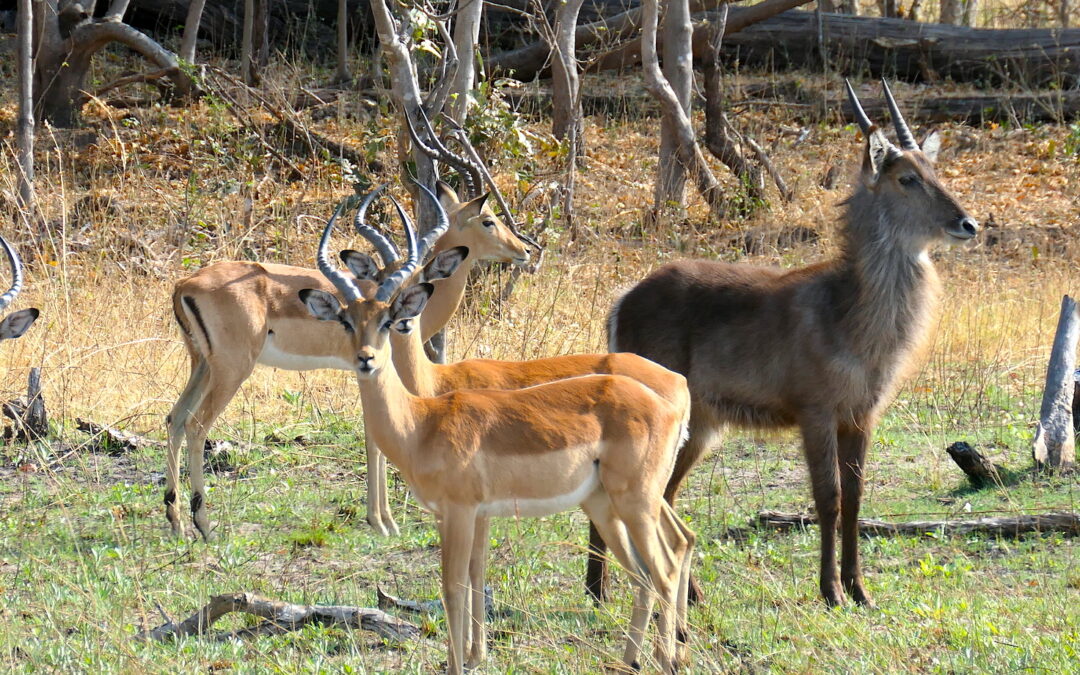
The Animals of Botswana: Antelopes
Stop!
Take a second and close your eyes.
Now, I want you to picture yourself on safari. What do you see?
If you’re not seeing some of the incredible animals of Botswana, you’re not on the right safari.
90 percent of Botswana is covered in savanna, which means it’s rich in vegetation and a lot of great food for herbivores. In fact, you can find 2500 species of plants and 650 species of trees feeding hundreds of thousands of animals.
And that launches our first Brave Africa blog series: The Animals of Botswana. To kick things off, we’re talking about the almost two dozen different types of antelopes you’ll find throughout the country. You could see many of these on your next game drive with us.
[embedyt] https://www.youtube.com/watch?v=iPXzMlWBR_E[/embedyt]
Eland
Eland are the largest of the African antelopes at 150-190cm at the shoulder. However, that large size means that these guys are also the slowest. They survive thanks to their incredible endurance that allows them to trot indefinitely. They can also leap big distances.
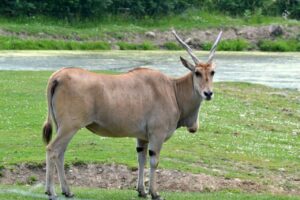 How to recognize Eland:
How to recognize Eland:
- Eland have a large dewlap—a flap of skin on the chest—which can reach all the way down to their knees.
- They look a little like cattle
Where can you find Eland?
Elands enjoy dry regions and can be found in the semi-desert region of the Kalahari. You’ll also find them in savannas, dry forests, and open plains.
Kudu
Kudu are beautiful antelope known for their spiraled horns and their gruff bark, which is the loudest of all antelopes. The females go around in herds of six to twenty, while the males are often solitary. They are noted for their jumping abilities, easily clearing a 3m fence.
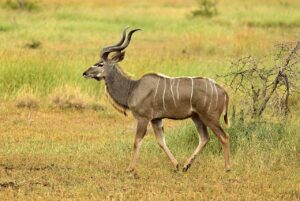 How to recognize Kudu
How to recognize Kudu
- Very large ears
- White nose-strip and body stripes
- Males have beautifully spiraled horns
Where can you find Kudu?
Kudu can be found all over Botswana, but are most often in large numbers along the Chobe and Linyanti rivers.
Roan
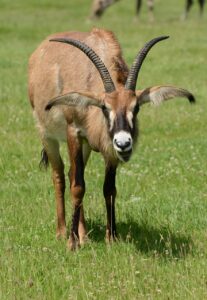 Roan are highly dependent on water and are limited to exclusive ranges, which has resulted in low population numbers. They congregate in herds of up to 20 Roan with a single bull. These highly unique animals of Botswana confront predators instead of running from predators, using their scimitar-shaped horns.
Roan are highly dependent on water and are limited to exclusive ranges, which has resulted in low population numbers. They congregate in herds of up to 20 Roan with a single bull. These highly unique animals of Botswana confront predators instead of running from predators, using their scimitar-shaped horns.
How to recognize Roan
- Fawn color with black and white facial markings
- Shorter, curved horns
Where can you find Roan?
Roan can be found in well-grassed and wooded areas with permanent water. The best viewing is in Chobe and Moremi.
Sable
Sable are highly territorial and will chase off competition. The males will emit a powerful odor that even humans can smell or try to intimidate others with their tail and horns. Breeding herds can be as large as 20 or 30 individuals, but males are always on their own. As for their horns, they’ll use them to attack lions who may jump on their backs.
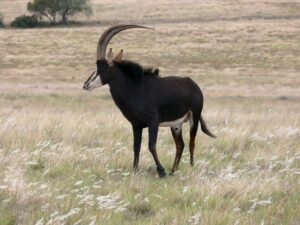 How to recognize Sable
How to recognize Sable
- Sloping backs
- Black coloring with white rumps, bellies, and faces
- Very long curved horns
Where can you find Sable?
Sable can be found in well-grassed open woodlands where there is water. The best viewing is around the Chobe River, Linyanti, and Moremi.
Gemsbok
Gemsbok are well adapted to survive in high heat, having learned to use every drop of available moisture. These Botswana antelopes are startlingly attractive and can be found in small herds. Their horns are incredibly effective when it comes to taking down predators, and have been known to impale lions, killing them.
 How to recognize Gemsbok
How to recognize Gemsbok
- Long straight horns
- Grey coloring with black and white markings on the face, legs, and belly.
Where can you find Gemsbok?
Gemsbok prefer open sandy grasslands or scrublands in the desert. Best viewing is in Nxai Pan, Deception Valley, and Makgadikgadi.
Wildebeest
Wildebeest are highly territorial antelopes that hang out in large herds of up to 30 individuals. They are migratory animals and will travel 50 km in a day to get to green flush vegetation. These nomadic creatures are relentless when they begin migrating and can travel 1,610 km in a year.
 How to recognize Wildebeest
How to recognize Wildebeest
- Broad muzzle with a ride row of incisors, loose lips, and curving horns
- Gray coat with a black mane
- Heavily built
Where can you find Wildebeest?
Wildebeest prefer grass plains and abundant water. They can be found all over Botswana throughout the Okavango Delta and Kalahari.
Red Hartebeest
 Red Hartebeest are incredibly fast runners. They can easily attain a speed of 65 km/hr, and when combined with their exceptional endurance, it makes them difficult prey. Preferring dry regions, Red Hartebeest get sufficient moisture from their diet, which includes melons. They do not need to drink water to survive.
Red Hartebeest are incredibly fast runners. They can easily attain a speed of 65 km/hr, and when combined with their exceptional endurance, it makes them difficult prey. Preferring dry regions, Red Hartebeest get sufficient moisture from their diet, which includes melons. They do not need to drink water to survive.
How to recognize Red Hartebeest
- Straight back, long and narrow face with closely set horns in a heart shape
- Whitish rump with black patches on the upper legs and face
Where can you find Red Hartebeest?
Red Hartebeest love arid regions with dry grassy plains. Best viewing is in the Central Kalahari and Kalagadi Gemsbok Park.
Tsessebe
Tsessebe form herds of either breeding females with a male or young bachelor herds. You’ll frequently find Tsessebe standing on termite hills to use as a vantage point to check for approaching danger. They are also reputed to be the fastest Botswana antelope, reaching speeds of 100 km/hr with a bouncing run.
How to recognize Tsessebe
- Sloping backs with widely set, outwardly curving horns
- Dark brown coloring with a purplish sheen
Where can you find Tsessebe?
Tsessebe can be found in grasslands and flood plains. In the winter, you’ll find them in the Savuti Marsh, and at other times, in Moremi.
Waterbuck
 Waterbuck form large herds of up to 30 individuals. They are usually found near water, though they’ll also head to open woodlands to graze. The males are very territorial and may fight to the death in certain situations.
Waterbuck form large herds of up to 30 individuals. They are usually found near water, though they’ll also head to open woodlands to graze. The males are very territorial and may fight to the death in certain situations.
How to recognize Waterbuck
- A distinctive white ring around the tail
- Shaggy fur
Where can you find Waterbuck?
Waterbuck can be found in the floodplains near water. Best viewing for these particular animals of Botswana is in Moremi and Chobe River.
Sitatunga
The medium-sized Sitatunga live almost permanently in water in the flooded areas of the Okavango Delta. They are very capable, if slow, swimmers, sometimes fully submerging themselves if there is danger nearby. They are solitary animals that are occasionally found in pairs and always found near papyrus.
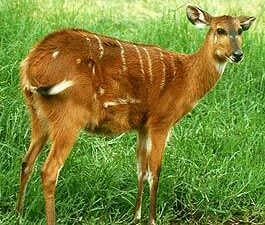 How to recognize Sitatunga
How to recognize Sitatunga
- Spirally twisted horns
- Body stripes on a dark shaggy coat
- Hunched appearance with a narrow face
Where can you find Sitatunga?
Sitatunga hang out in permanent swamps and thick cover. Best viewing is in shallow waters.
Red Lechwe
Red Lechwe spend all their time near water. You’ll often find then wading up to their bellies in shallow waters to reach aquatic plants. They live in separate male and female herds with enforced separation due to territorial males. When startled, these Botswana antelopes will scatter in all directions to confuse predators.
 How to recognize Red Lechwe
How to recognize Red Lechwe
- Black lines on the front legs
- Long, thin, and sweeping horns
- Stockier than the impala
Where can you find Red Lechwe?
Red Lechwe enjoy the wetlands with best viewing along the Chobe River, Linyanti, Moremi, and Okavango.
Puku
Puku are easily overlooked. They can be confused with Impala or Red Lechwe, but are slightly smaller in size. You can find them on the dry fringes of swampland and rivers, recognizing them by the repeated whistle they make when disturbed. They live in small segregated herds with territorial males.
How to recognize Puku
- Uniformly red
- Smaller in size and stouter
Where can you find Puku?
Puku can only be found along the Chobe River near Kasane. They are one of Botswana’s conserved animals.
Impala
Impala are the most abundant Botswana antelopes. They are perfectly proportioned animals that are easily startled or frightened. They live in large herds of up to 100 individuals with females outnumbering males two to one. They can reach running speeds of 80 km/hr and leap 3 meters high.
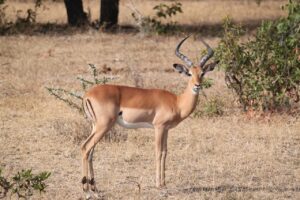 How to recognize Impala
How to recognize Impala
- Black and white lines on the rump in the shape of an “M”
- Dainty black ankle straps and a black patch on the forehead
Where can you find Impala?
Impala can be found all over Botswana, particularly in Moremi and Chobe.
Springbok
Springbok are well suited to dry, dusty areas. Unlike most other antelope, they do not have a moist external nose, giving them something in common with a camel. You can recognize them by their peculiar stotting and springing leaps, called pronking. With straight legs, they can leap up two meters.

How to recognize Springbok
- Ghostly white faces, bellies, and sides
Where can you find Springbok?
Springbok enjoy dry, open grasslands. The best viewing is in Nxai Pan, Central Kalahari, Khutse, and more.
Bushbuck
Bushbuck are solitary, nonterritorial antelopes—the only nonterritorial antelope in Africa. While each adult has their own thicket, they tolerate each other well. However, that doesn’t mean that the males can’t be aggressive. When cornered by predators, they will fight back, killing leopards and dogs.
How to recognize Bushbuck
- Males have spiral horns
- Distinctive spots and stripes on the body
Where can you find Bushbuck?
Bushbuck enjoy dense bush near water. You’ll find these animals of Botswana near the Chobe River, Linyanti, Moremi, and throughout the Okavango.
Reedbuck
You’ll usually find Reedbuck in long grasses and in small groups of up to six individuals. They depend on thick shelter for protection from predators and will use a piercing whistle when alarmed. Reedbuck mate for life in monogamous relationships.
How to recognize Reedbuck
- Yellowish-grey coloring with a white under-tail
- Dark brown lines on their front legs
Where can you find Reedbuck?
Reedbuck enjoy tall grassland near water. They can be found in Moremi, Chobe, and Okavango.
Mountain Reedbuck
Mountain Reedbuck live in small, isolated groups, and are under the threat of extinction. Timid animals, they tend to hide undercover all day and only emerge at dusk to eat and drink. They are dependent on water and must drink on a regular basis.
How to recognize Mountain Reedbuck
- Short, curved horns
- Greyish brown fur, rufous necks, and white undersides with a bushy tail
- Dark scent patch underneath the ears
Where can you find Mountain Reedbuck?
Mountain Reedbuck spend their times in rocky hills with scrub and grass for cover. They are endangered and are found in the Mokolodi Game Reserve.
Klipspringer
Klipspringer have incredible climbing and jumping abilities, which gives them an advantage over predators. They are very agile and can easily bound up rock walls that are nearly vertical. They are well adapted to extreme habitats and can use their blunt, rubbery, skid-proof hooves to maneuver where they will. They mate for life and live in family groups with one or two offspring.
How to recognize Klipspringer
- Short and stout with muscular bodies
- Yellowish gray to reddish-brown coat
Where can you find Klipspringer?
Klipspringer can be found in rocky areas with the best viewing in Savuti, Ngoma, and Tuli.
Sharpe’s Grysbok
Sharpe’s Grysbok are rare Botswana antelopes. They are nocturnal animals that spend their days in protective covers and will run away at the slightest hint of anything bad. They are usually solitary, but can sometimes be found in pairs during mating season.
How to recognize Sharpe’s Grysbok
- Small, dark, and stocky with a slightly hunched back
- Long fur on their hindquarters
- Whitish flecks on a reddish-brown coat.
Where can you find Sharpe’s Grysbok?
Sharpe’s Grysbok enjoy thick vegetation below rocky outcrops. Best viewing is Buffalo Ridge at Ngoma.
Oribi
It’s rare to see an Oribi. They are one of Botswana’s conserved animals and are either found alone or in pairs. When disturbed, an Oribi gives a sharp whistle or a sneeze-like snort before running away. They are territorial, but will bound away if threatened.
How to recognize Oribi
- Yellow to orange-brown fur on the back and upper chest while the chin, throat, belly, and rump are white.
- Short, bushy tail with black or dark brown upperparts
- Only males have horns that are slender and upright
Where can you find Oribi?
Oribi enjoy large grassy plains with short grass for grazing.
Duiker
Duiker are solitary animals and nocturnal. They are creatures of habit that always use the same paths for resting and latrines. They are considered the most successful antelope in Africa, scavenging fruit below trees where monkeys feed and surviving in a wide range of habitats. They are extremely territorial and will stalk and charge intruders. Duiker are held sacred by the Bangwato tribe.
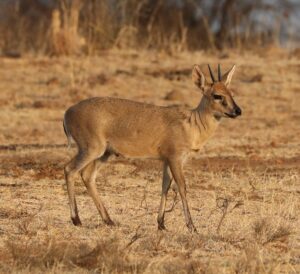 How to recognize Duiker
How to recognize Duiker
- Greyish-yellow with a conspicuous tuft of hair on their forehead
- Long black nose line and long narrow ears
- Closely set horns with ridges
Where can you find Duiker?
Duiker prefer scrub savannah, but they will tolerate most habitats. Best viewing is in the Western and Central Kalahari.
Steenbok
Steenbok are extremely territorial and refuse to leave their food supply. They live alone unless they mate and then stay in a breeding pair. Surprisingly, they can and will eat meat, killing mice and birds as needed for protein. They run in a zig-zag pattern, frequently stopping to look back for pursuit and additional danger. They are the only Botswana antelope to cover their defecation by scaping sand over the spot.
How to recognize Steenbok
- Small animals with large wide-set ears with a distinct leaf-like pattern on the inside
- Smooth horns and a red tail
Where can you find Steenbok?
Steenbok have a wide habitat but prefer short grasslands and shrubs. You can find them in dry areas throughout Botswana.


